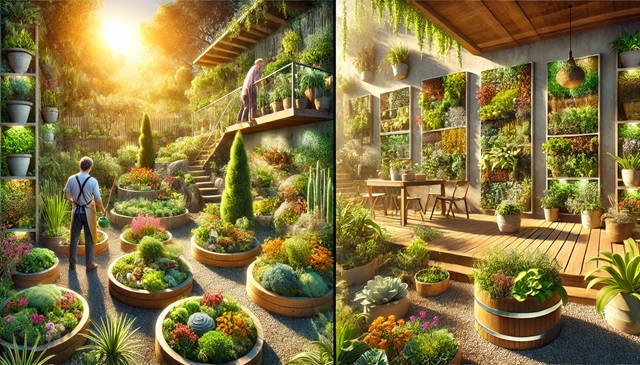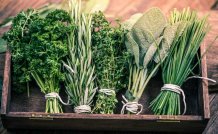Online Class: Tropical Gardening 101

no certificate
with CEU Certificate*
-
13Lessons
-
16Exams &
Assignments -
198Students
have taken this course -
4Hours
average time -
0.4CEUs
Course Description
Unearth the Beauty of Tropical Gardening: A Beginner’s Odyssey
Evoke the magic and allure of lush tropical landscapes right in your backyard! Our meticulously crafted course, dedicated to the splendors of tropical gardening, is tailored specifically for budding garden enthusiasts. Whether you're just planting your first tropical seedling or seeking to rejuvenate an inherited tropical haven, this course is your gateway to a botanical paradise.
Begin your journey by immersing yourself in the rich tapestry of tropical flora. Discover the origins of these exotic beauties, grasp their intricate functioning, and delve deep into their unique requirements. Equipped with this knowledge, handpick from an array of vibrant tropical plants to adorn your garden.
But cultivating a tropical garden isn't merely about plant selection. Understand the nuanced art of nourishing, safeguarding, pruning, and sculpting these plants, ensuring they not only survive but flourish spectacularly in your space. Navigate the challenges of tropical gardening with ease, from combating pests to mitigating diseases.
For those committed to eco-friendly gardening, we delve into the principles of organic gardening, guiding you to curate a garden that's in harmony with nature. Beyond this, master the skills of effective garden planning and discern the tropical garden archetype that aligns perfectly with your aspirations and the unique character of your space.
Fear not if you've been told you lack the elusive 'green thumb'. With our expert guidance, you'll unearth your innate gardening prowess and learn the secrets to making your tropical retreat thrive.
Dive in and let us guide you in weaving the vibrant threads of the tropics into your very own garden tapestry! Join our course today and embark on a botanical journey like no other.
Course Motivation
If you look at a globe of the Earth, you will notice there are distinct zones in which certain countries and continents lie. In the middle of the globe, halfway between the North and South poles, is the equator. This line separates the northern and southern hemispheres from each other, even though it is not an actual feature of the lands.
The line is where the climates of the Earth can also be separated. The areas that are close to the equator are considered tropical, as they have the highest temperatures and they have the best conditions for growing tropical plants.
These areas are not only hot, but some of these areas also have higher levels of moisture, which allow for better growing conditions.
(After all, the Sahara Desert also lies along the equator, but verdant tropical gardening is not possible there.)
However, it is not just the equator that designates where tropical plants can be found. There are also two other lines of measurement that have been placed onto maps for reference.
These lines are the Tropic of Cancer and the Tropic of Capricorn, located respectively, above and below the equator. Within these lines, slightly above, and below them are the higher temperatures and the ability for people to grow tropical plants.
Of course, the Earth itself already has plants that are tropical in those areas, so humans are not completely responsible for the growing patterns there.
While the tropical plants in these tropical zones are lush and vibrant, this does not necessarily mean that the plants have stayed in those areas forever.
Since it is possible for us to buy potted plants from tropical regions and to find tropical plants in some non-tropical areas of the world, thus, it is clear that the plants were brought to new areas over the course of time.
Many people believe that the tropical plants of today were brought into other areas by explorers of the period. When the explorers saw that the plants were new and exciting, they decided to bring them back to their homelands.
This did not always mean that the plants survived and thrived, but the introduction of many plants was a successful one.
Think about the introduction of the orchid or the palm tree, not native to Europe in the time of the explorers. In addition, the rubber tree plant of India was also brought into new countries.
Once these plants were brought in and cultivated, then the people of the areas would bring the plants into other areas, and those people then brought the plants into other areas.
Before long, tropical plants were not long confined to their original home. They had found a number of new homes, and now, they might find a home in your backyard.
Summary
Tropical plants are generally found within the tropical zone of the world, between the Tropics of Cancer and Capricorn, the two lines of delineation above and below the equator.
These plants were found by the explorers from Europe and then brought into other countries with trade and through successful planting.
- Completely Online
- Self-Paced
- 6 Months to Complete
- 24/7 Availability
- Start Anytime
- PC & Mac Compatible
- Android & iOS Friendly
- Accredited CEUs

Course Lessons
Lesson 1. History of Tropical Plants
 Lesson discussions: Reasons for Taking this Course
Lesson discussions: Reasons for Taking this Course Complete Assignment: An Introduction
Complete Assignment: An Introduction Assessment: Lesson 1: History of Tropical Plants
Assessment: Lesson 1: History of Tropical Plants
Lesson 2. Types of Tropical Plants
 Lesson discussions: Tropical Plants
Lesson discussions: Tropical Plants Complete: Lesson 2 Assignment
Complete: Lesson 2 Assignment Assessment: Lesson 2: Types of Tropical Plants
Assessment: Lesson 2: Types of Tropical Plants
Lesson 3. Common Tropical Plants
 Assessment: Lesson 3: Common Tropical Plants
Assessment: Lesson 3: Common Tropical Plants
Lesson 4. Tropical Garden Ideas
 Assessment: Lesson 4: Tropical Garden Ideas
Assessment: Lesson 4: Tropical Garden Ideas
Lesson 5. Planting
 Assessment: Lesson 5: Planting
Assessment: Lesson 5: Planting
Lesson 6. Growing
 Assessment: Lesson 6: Growing
Assessment: Lesson 6: Growing
Lesson 7. Pruning
 Assessment: Lesson 7: Pruning
Assessment: Lesson 7: Pruning
Lesson 8. Protecting
 Assessment: Lesson 8: Protecting
Assessment: Lesson 8: Protecting
Lesson 9. Common Growing Problems and Solutions
 Lesson discussions: Garden Problems
Lesson discussions: Garden Problems Assessment: Lesson 9: Common Growing Problems & Solutions
Assessment: Lesson 9: Common Growing Problems & Solutions
Lesson 10. How to Plan Your Tropical Garden
 Assessment: Lesson 10: How to Plan Your Tropical Garden
Assessment: Lesson 10: How to Plan Your Tropical Garden
Lesson 11. Organic Gardening Options
 Lesson discussions: Organic Gardening
Lesson discussions: Organic Gardening Assessment: Lesson 11: Organic Gardening Options
Assessment: Lesson 11: Organic Gardening Options
Lesson 12. How to Train Tropical Plants
 Assessment: Lesson 12: How to Train Tropical Plants
Assessment: Lesson 12: How to Train Tropical Plants
Lesson 13. Conclusion
 Lesson discussions: What is your opinion of this course?; Program Evaluation Follow-up Survey (End of Course); Course Comments
Lesson discussions: What is your opinion of this course?; Program Evaluation Follow-up Survey (End of Course); Course Comments Complete: Lesson 13 Assignment
Complete: Lesson 13 Assignment Assessment: The Final Exam
Assessment: The Final Exam
Learning Outcomes
- Summarize the history of tropical plants.
- Describe types of tropical plants.
- Identify common tropical plants.
- Describe tropical garden ideas and techniques for planting, growing, pruning, and protecting a tropical garden.
- Identify common growing problems and solutions.
- Describe how to plan your tropical garden.
- Summarize how to train tropical plants.
- Demonstrate mastery of lesson content at levels of 70% or higher.
Additional Course Information

- Document Your Lifelong Learning Achievements
- Earn an Official Certificate Documenting Course Hours and CEUs
- Verify Your Certificate with a Unique Serial Number Online
- View and Share Your Certificate Online or Download/Print as PDF
- Display Your Certificate on Your Resume and Promote Your Achievements Using Social Media

Choose Your Subscription Plan
No Certificate / No CEUs
This course only
| Includes certificate | X |
| Includes CEUs | X |
| Self-paced |

|
| Instructor support |

|
| Time to complete | 6 months |
| No. of courses | 1 course |
Certificate & CEUs
This course only
| Includes certificate |

|
| Includes CEUs |

|
| Self-paced |

|
| Instructor support |

|
| Time to complete | 6 months |
| No. of courses | 1 course |
Certificates & CEUs
Includes all 600+ courses
| Includes certificate |

|
| Includes CEUs |

|
| Self-paced |

|
| Instructor support |

|
| Time to complete | 12 Months |
| No. of courses | 600+ |
Certificates & CEUs
Includes all 600+ courses
| Includes certificate |

|
| Includes CEUs |

|
| Self-paced |

|
| Instructor support |

|
| Time to complete | 24 Months |
| No. of courses | 600+ |
Student Testimonials
- "It was all very informative." -- Catharine A.
- "Everything was helpful, and it was broken down into useful sections." -- Thomas P.
Related Courses
-
 8 hours
0.8 CEUs
Aromatherapy (Intermediate to Advanced)
+ More Info
8 hours
0.8 CEUs
Aromatherapy (Intermediate to Advanced)
+ More Info
-
 10 hours
1.0 CEUs
Interior Design 101
+ More Info
10 hours
1.0 CEUs
Interior Design 101
+ More Info
-
 8 hours
0.8 CEUs
Interior Decorating Made Easy
+ More Info
8 hours
0.8 CEUs
Interior Decorating Made Easy
+ More Info
-
 7 hours
0.7 CEUs
Soap Making 101
+ More Info
7 hours
0.7 CEUs
Soap Making 101
+ More Info
-
 5 hours
0.5 CEUs
Bread Baking 101
+ More Info
5 hours
0.5 CEUs
Bread Baking 101
+ More Info
-
 6 hours
0.6 CEUs
Pie Baking 101
+ More Info
6 hours
0.6 CEUs
Pie Baking 101
+ More Info
-
 9 hours
0.9 CEUs
Landscaping 101
+ More Info
9 hours
0.9 CEUs
Landscaping 101
+ More Info
-
 7 hours
0.7 CEUs
Microsoft Excel Level 2
+ More Info
7 hours
0.7 CEUs
Microsoft Excel Level 2
+ More Info
-
 10 hours
1.0 CEUs
Floral Arrangement 101
+ More Info
10 hours
1.0 CEUs
Floral Arrangement 101
+ More Info
-
 3 hours
0.3 CEUs
Vegetable Gardening 101
+ More Info
3 hours
0.3 CEUs
Vegetable Gardening 101
+ More Info
-
 5 hours
0.5 CEUs
Home Safety
+ More Info
5 hours
0.5 CEUs
Home Safety
+ More Info
-
 9 hours
0.9 CEUs
How to Decorate a Room
+ More Info
9 hours
0.9 CEUs
How to Decorate a Room
+ More Info
-
 6 hours
0.6 CEUs
Introduction to Gardening
+ More Info
6 hours
0.6 CEUs
Introduction to Gardening
+ More Info







